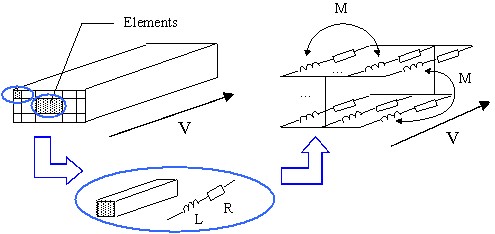Unidirectional Conductors: about
Definition
A Unidirectional Conductor is a tubular (1D) conductor for which it is possible to identify a privileged path of the electric current.
Creation
A Unidirectional Conductor is created:
- automatically if resulting from a Geometric Tube
- directly by the user if resulting from a classic geometry description*
Orientation
A Unidirectional Conductor is always oriented (in order of the current input/output).
The orientation is defined as follows:
-
for a Unidirectional Conductor resulting from a Geometric Tube: the orientation is defined by the order of the Tube Points belonging to the neutral fiber
-
for a Unidirectional Conductor by Assimilation: the orientation is defined starting from the input/output faces of the current
Coherency
The section of the Unidirectional Conductor is unique along the path. Any change of the section shape involves the creation of another Unidirectional Conductor.
Meshing
In order to perform simulations, the section of the Unidirectional Conductor is meshed, i.e. the conductor is split up into elementary wires in which the current density is supposed to be uniform, as illustrated in the image below.

In “Supplied Conductors (AC)” and “Supplied Conductors (DC) – ARCAD” applications, it is furthermore possible to assign to Unidirectional Conductors a meshing in the length, i.e. to saw the elementary wires into shorter pieces. This second discretization can also be applied during result post-processing phase, because it has no effects on the computation of the current density in the conductor.
On the other hand, it makes it possible to refine some computations of the magnetic flux density and of the Laplace forces, as well as their graphical displaying. In particular:
- in “ Supplied Conductors (AC) ” application, only the global computation of the Laplace force in a list of conductors can be improved by means of a larger number of length-meshing elements;
- in “ Supplied Conductors (DC) – ARCAD ” application, in addition of the global computation cited above, the discretization in the length enables to make denser the displayed arrows for the magnetic flux density, the per-unit-length and the volumic Laplace forces on conductors.
Terminals
The terminals of Unidirectional Conductors are automatically created.
They are defined as follows:
-
for Unidirectional Conductors resulting from a Geometric Tube: a terminal is created for each Tube Point defining the neutral fiber
-
for Unidirectional Conductors by Assimilation: terminals correspond to the current input/output faces, which the user would be entered first during the conductor creation